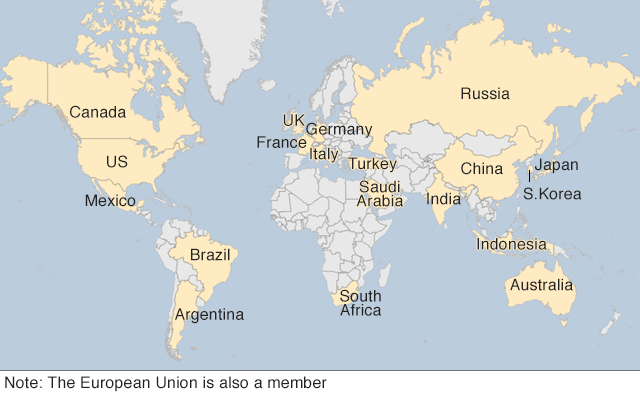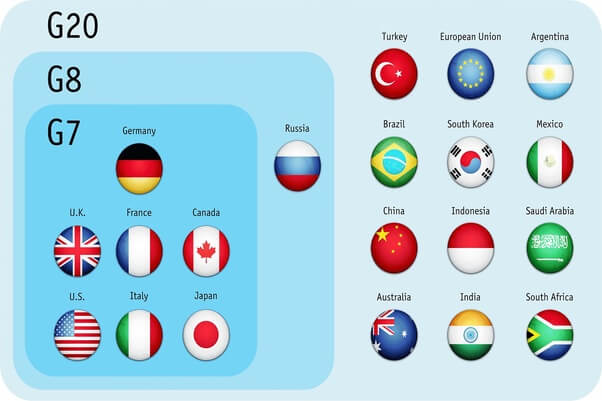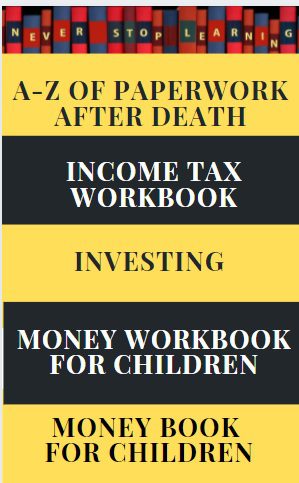What is G20? What do World leaders talk about? Where is G20 Summit being held in 2019? How does G20 differ from G7?
Table of Contents
G20 Osaka Summit
The G20 Summit will be held over two days, on June 28-29, 2019 in Osaka, Japan where world leaders will meet. Leaders also have many important talks on the sidelines of the summit. Ministerial meetings were also be held in eight cities throughout Japan in early June.
In 2019 trade, climate change and the crisis in relations with Iran will be big topics.
Separate talks are set to take place between Mr Trump and Chinese President Xi Jinping. And between Mr Trump and Indian prime minister Narendra Modi to talk about tariffs. India imposed retaliatory tariffs on 28 US products in June 2019, after the US announced it was withdrawing India’s preferential trade treatment.
What is G20?
G20 stands for Group of Twenty(20). At G20 the world leaders get together once a year to discuss the most important financial and economic issues of the day to coordinate their plans. Often, big demonstrations take place around the summit. And the heads of government often pose together for a group photograph also called Family Photograph.
- For example at the 2009 summit in London, world leaders committed themselves to put a $5 trillion injection into the global economy. This was to try and curb the worst effects of the financial crisis.
- But other topics are often covered: for example, the forum debated how to manage a partial cease-fire in Syria at the 2017 summit.
The first G20 meeting was in 1999 in Berlin, after a financial crisis in East Asia affected many countries around the world.
At first, the G20 was mostly attended by finance ministers and central bank governors. But after the global financial crisis in 2008 with banks collapsing, unemployment rising and wages stagnating, the organisation turned into an emergency council for presidents and prime ministers. Now, they always attend.
The official website is G20.org.
Who are members of G20?
The leaders in G20 are from the countries with the largest and fastest-growing economies. Its members account for 85% of the world’s GDP, and two-thirds of its population
The members are Argentina, Australia, Brazil, Canada, China, Germany, France, India, Indonesia, Italy, Japan, Mexico, Russia, Saudi Arabia, South Africa, South Korea, Turkey, the United Kingdom, the United States and the European Union.
Representative include, at the leaders’ summits, the leaders of 19 countries and of the European Union, and, at the ministerial-level meetings, the finance ministers and central bank governors of 19 countries and of the European Union.
Spain is a permanent guest invitee, the Chair of ASEAN; two African countries (the chair of the African Union and a representative of the New Partnership for Africa’s Development) and a country (sometimes more than one) invited by the presidency, usually from its own region.
2020 Summit will be held in Saudi Arabia and 2022 Summit will be held in India.

Members of G20
How does G20 differ from G7 or G8
G7 or G-7, or “group of seven,” mainly deals with politics. After the first oil crisis of the 1970s, economies across the world were suffering, and global leaders wanted to do something about it. So, a group of government officials decided to meet and figure things out.
Members are Canada, France, Germany, Italy, Japan, the United Kingdom and the United States. In addition, the presidents of the European Council and the European Commission represent the EU at G-7 summits.
In 1998, Russia joined the club, making it the G-8, but it was kicked out in 2014 after its annexation of Crimea. So now we’re back to G-7. However, Trump said Friday that Russia should be reinstated in G-7 talks.
The G-20 is all about money and has 20 members. Its members represent 85 percent of global economic output, and it’s a little less exclusive than the G-7.

Difference between G7, G8 and G20
Who is the head of G20?
The G20 presidency is selected from the members. The G20 operates without a permanent secretariat or staff.
The group’s chair rotates annually among the members and is selected from a different regional grouping of countries. Generally, at each Summit, the G20 selects a country by consensus, two years in advance of its presidency. At its inception, the term of the G20 presidency was six months. Since 2011, the term has been 1 year from December through the following November.
The incumbent chair establishes a temporary secretariat for the duration of its term, which coordinates the group’s work and organizes its meetings. To ensure continuity, the presidency is supported by a “troika” made up of the current, immediate past and next host countries.
The 2017 chair was Germany, which hosted the 2017 Summit in Hamburg. The 2019 chair is Japan, which is hosting the 2019 G20 Osaka summit. The 2020 summit will be held in Saudi Arabia.
How is the President of the G20 selected?
To decide which member nation gets to chair the G20 leaders’ meeting for a given year, all members, except the European Union, are assigned to one of five different groupings. Each year, a different G20 member country assumes the presidency starting from 1 December until 30 November. This system has been in place since 2010, when South Korea, which is in Group 5, held the G20 chair. The table below lists the nations’ groupings:
All countries within a group are eligible to take over the G20 Presidency when it is their group’s turn. Therefore, the states within the relevant group need to negotiate among themselves to select the next G20 President.
| Group 1 | Group 2 | Group 3 | Group 4 | Group 5 |
|---|---|---|---|---|
|
|
|
|
|
Family Photograph
The heads of governments in the G20 pose together for a group photograph ahead of the formal start of the summit, also called as Family Photograph.
In 2018 Saudi Crown Prince Mohammed bin Salman was relegated to the very end of a row on the right though he was one of the first on the podium in Buenos Aires ahead of the formal start of the summit. He might have been standing on the fringes of the traditional “family photo” at the Group of 20 summit in Argentina, but he got lots of attention. Mohammed bin Salman alleged to have ordered the killing of journalist Jamal Khashoggi

G20 Family Photograph
Demonstrations before G20
- In 2009 Ian Tomlinson, a newspaper seller, was killed in G20 protests in London.
- In 2018 Thousands of demonstrators marched in Buenos Aires to protest the G20’s economic policies last year.
- In 2019 protests against Hong Kong’s extradition bill have been planned ahead of the summit.
Summits of G20
The following list of G20 summits summarizes all G20 conferences
| Date | Host country | Host city | Host leader | |
|---|---|---|---|---|
| 1st | 14–15 November 2008 | Washington, D.C. | George W. Bush | |
| 2nd | 2 April 2009 | London | Gordon Brown | |
| 3rd | 24–25 September 2009 | Pittsburgh | Barack Obama | |
| 4th | 26–27 June 2010 | Toronto | Stephen Harper | |
| 5th | 11–12 November 2010 | Seoul | Lee Myung-bak | |
| 6th | 3–4 November 2011 | Cannes | Nicolas Sarkozy | |
| 7th | 18–19 June 2012 | San José del Cabo, Los Cabos | Felipe Calderón | |
| 8th | 5–6 September 2013 | Saint Petersburg | Vladimir Putin | |
| 9th | 15–16 November 2014 | Brisbane | Tony Abbott | |
| 10th | 15–16 November 2015 | Serik, Antalya | Recep Tayyip Erdoğan | |
| 11th | 4–5 September 2016 | Hangzhou | Xi Jinping | |
| 12th | 7–8 July 2017 | Hamburg | Angela Merkel | |
| 13th | 30 November – 1 December 2018 | Buenos Aires | Mauricio Macri | |
| 14th | 28–29 June 2019 | Osaka | Shinzō Abe | |
| 15th | 21–22 November 2020 | Riyadh | Salman | |
| 16th | TBD 2021 | candidate city: Bari | ||
| 17th | TBD 2022 | New Delhi | Narendra Modi | |
| 18th | TBD 2023 | TBD |
1997 Asian financial crisis
The Asian financial crisis was a period of the financial crisis that gripped much of East and Southeast Asia beginning in July 1997 and raised fears of a worldwide economic meltdown. Indonesia, South Korea, and Thailand were the countries most affected by the crisis.
The crisis started in Thailand with the financial collapse of the Thai baht after the Thai government was forced to float the baht due to lack of foreign currency to support its currency peg to the U.S. dollar. Capital flight ensued, beginning an international chain reaction. At the time, Thailand had acquired a burden of foreign debt that made the country effectively bankrupt even before the collapse of its currency.
As the crisis spread, most of Southeast Asia and Japan saw slumping currencies, devalued stock markets and other asset prices, and a precipitous rise in private debt.
Although most of the governments of Asia had seemingly sound fiscal policies, the International Monetary Fund (IMF) stepped in to initiate a $40 billion program to stabilize the currencies of South Korea, Thailand, and Indonesia, economies particularly hard hit by the crisis.
Hong Kong, Laos, Malaysia and the Philippines were also hurt by the slump. Brunei, China, Singapore, Taiwan, and Vietnam were less affected, although all suffered from a loss of demand and confidence throughout the region. Japan was also affected, though less significantly.
Is the G20 a success?
It has also been dismissed as a “talking shop”, where little real progress is made.
It’s been suggested that the group’s small size is a curse and a blessing.
Having a small number of leaders involved might mean that decisions can be made more quickly.
But it has been argued that excluding a large number of countries from important discussions isn’t fair. About 170 countries aren’t invited to the meetings.
Related Articles:
- What is IMF? How does it work? Difference from World Bank
- UN, IMF, World Bank: Rich and Poor countries of World, MUN
- What is Inflation? How is it Calculated? WPI, CPI in India,HyperInflation
- What is GDP, Gross Domestic Product
- What are Central Banks,What is RBI? What do they do?
Do you think such summits are good? How should the world leader meet?



